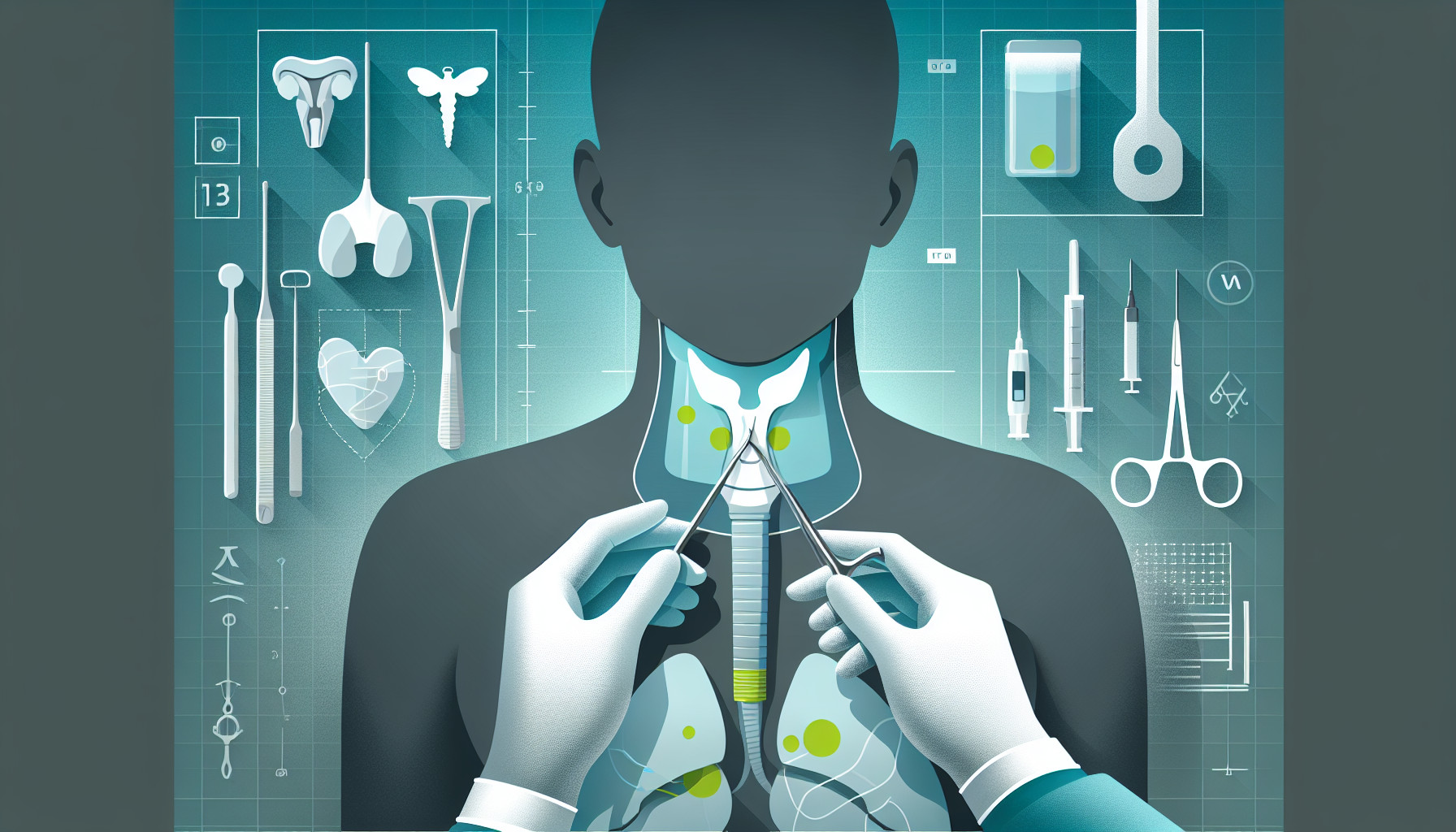Our Summary
This study looks at new ways to perform thyroid and parathyroid surgeries using a robot-assisted method. The operations were performed by making an incision behind the ear, a method known as a retroauricular approach. The study involved 40 operations on 38 women, and the results were compared to surgeries performed without a robot. Some of the patients also had neck lift surgery at the same time as their thyroid surgery.
The results showed that all surgeries were completed successfully, with no need to switch to a more traditional open surgery method. Some patients experienced minor complications such as hoarseness and bleeding, but these were temporary. The average time for the operation was around 156 minutes, and most patients were able to leave the hospital the same day or the day after.
The study concludes that this new robotic method for thyroid and parathyroid surgeries is safe and could be a good option for certain patients. The non-robotic version of the surgery is also safe, but more research is needed to understand the benefits and limitations of both methods.
FAQs
- What is the retroauricular approach to thyroid and parathyroid surgeries?
- What were the reported complications and their frequency in the robot-assisted thyroid and parathyroid surgeries?
- How does the duration and recovery time of robot-assisted thyroid and parathyroid surgeries compare to the traditional method?
Doctor’s Tip
A helpful tip a doctor might tell a patient about thyroidectomy is to discuss with their healthcare provider the possibility of using a robot-assisted method for the surgery. This new approach has shown promising results in terms of safety and efficiency, with the potential for faster recovery times and fewer complications. It is important for patients to have an open conversation with their doctor about all available options for their thyroid surgery to determine the best course of action for their individual situation.
Suitable For
Patients who are typically recommended for thyroidectomy include those with:
Thyroid cancer: Patients with thyroid cancer may undergo thyroidectomy to remove part or all of the thyroid gland to treat the cancer.
Hyperthyroidism: Patients with hyperthyroidism, a condition where the thyroid gland produces too much thyroid hormone, may undergo thyroidectomy to remove the gland and alleviate symptoms.
Large goiters: Patients with large goiters, which are enlarged thyroid glands that may cause difficulty swallowing or breathing, may undergo thyroidectomy to remove the enlarged gland.
Recurrent thyroid nodules: Patients with recurrent thyroid nodules, which are lumps in the thyroid gland that may be causing symptoms or are suspicious for cancer, may undergo thyroidectomy to remove the nodules.
Graves’ disease: Patients with Graves’ disease, an autoimmune disorder that causes hyperthyroidism, may undergo thyroidectomy as a treatment option.
Thyroid nodules with suspicious features: Patients with thyroid nodules that have suspicious features on imaging studies or fine needle aspiration biopsy may undergo thyroidectomy to remove the nodules and determine if they are cancerous.
Overall, the decision to recommend thyroidectomy for a patient is based on their specific condition, symptoms, and the recommendation of their healthcare provider.
Timeline
Before thyroidectomy:
- Patient consults with a healthcare provider and undergoes diagnostic tests to determine the need for surgery.
- Patient may undergo pre-operative evaluations to assess overall health and readiness for surgery.
- Patient discusses risks and benefits of thyroidectomy with healthcare provider and makes an informed decision to proceed with surgery.
- Patient may need to make necessary arrangements for post-operative care and recovery.
After thyroidectomy:
- Patient undergoes surgery, which may involve a robotic-assisted approach or traditional open surgery.
- Patient is monitored in the recovery room and may stay in the hospital for observation depending on the extent of the surgery.
- Patient may experience temporary symptoms such as hoarseness, difficulty swallowing, and neck pain.
- Patient is discharged from the hospital and receives instructions for post-operative care at home.
- Patient may need to take thyroid hormone replacement medication for the rest of their life.
- Follow-up appointments are scheduled to monitor recovery and adjust medication dosage if needed.
What to Ask Your Doctor
- What are the potential risks and complications associated with a thyroidectomy using a robot-assisted method?
- How does the recovery process differ between a robot-assisted thyroidectomy and a traditional open surgery method?
- Are there any specific eligibility criteria or factors that would make me a good candidate for a robot-assisted thyroidectomy?
- How does the cost of a robot-assisted thyroidectomy compare to a traditional surgery method, and will my insurance cover it?
- What is the long-term success rate of robot-assisted thyroidectomies compared to traditional methods?
- Will I have any restrictions or limitations after undergoing a robot-assisted thyroidectomy, and if so, for how long?
- How many robot-assisted thyroidectomies have you performed, and what is your experience with this technique?
- Will I need to follow up with any additional appointments or tests after the surgery, and if so, how often?
- Are there any alternative treatment options to consider before moving forward with a thyroidectomy using a robot-assisted method?
- What can I expect in terms of scarring and cosmetic outcomes after a robot-assisted thyroidectomy, especially if I am also having neck lift surgery at the same time?
Reference
Authors: Alshehri M, Mohamed HE, Moulthrop T, Kandil E. Journal: Head Neck. 2017 Aug;39(8):1568-1572. doi: 10.1002/hed.24794. Epub 2017 May 5. PMID: 28474427
